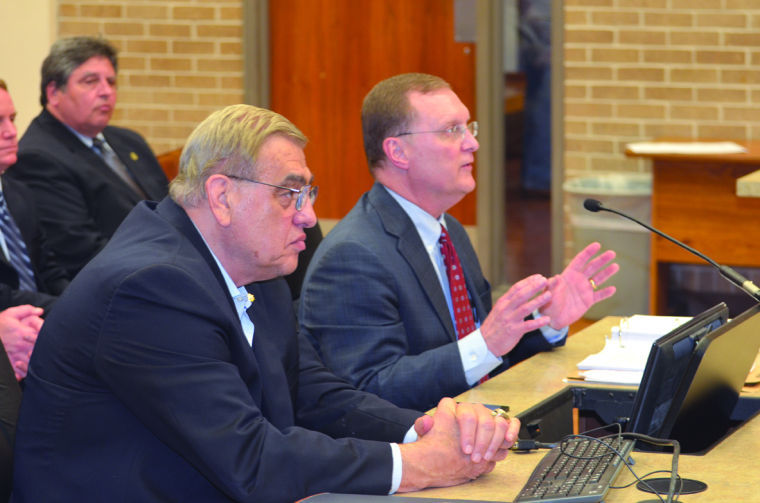New ordinance in action
Published 11:45 pm Friday, April 25, 2014
By David Vitrano
L’Observateur
CONVENT – St. James Parish’s new land-use ordinance received somewhat of a trial by fire Wednesday as two controversial industrial projects came to the parish Planning Commission seeking permits to begin construction.
The first of the two projects was the South Louisiana Methanol plant, which was announced in early 2013, and is slated to be located in the industry-heavy western portion of the west bank of the parish.
The other was the Petroplex tank storage facility, which was announced several years ago but has been mired in litigation for much of the time since.
Each case presented unique problems for the Planning Commission acting under the auspices of the new ordinance for the first time.
According to attorney Vic Frankiewicz, the special meeting was called at the behest of the two companies, eager to begin their respective projects.
Frankiewicz said the members of the commission have a couple of questions to ask themselves when such a request is made. The first consideration is whether the use is allowable under the land-use plan. In cases such as this, commission members must then ask themselves if the use is consistent with what is around it and make a decision about whether to grant the permit.
“Basically, you’re the decided,” he said.
The second consideration concerns requests that do not conform to the land-use plan. In these cases, the commission must make a recommendation to the Parish Council, which will then make the ultimate decision.
“Tonight on the agenda, you have one of each,” said Frankiewicz.
South Louisiana Methanol CEO Barry Williamson spoke on behalf of his company.
“We look forward to being the first one through the process,” he said.
Although in some ways the process was a mere formality as the project had already been given the green light, the company also sought approval for future expansion at the site, a point that proved a little more complicated for the commission.
Williamson explained how the site was chosen, saying the group looked at more than 200 sites in four states but settled on the present location for a number of reasons.
“We love the resources you have,” he said.
He also gave a quick explanation regarding the process used to make methanol — a process he insisted was clean and posed minimal threat to the surrounding environment.
“It’s very, very clean,” he said. “When you put clean in, you get clean out.”
Price Howard, project manager with South Louisiana Methanol, then spoke about the safety measures and environmental studies done in preparation for design and construction.
Still the reassurances did little to calm the fears of residents of the area where the plant will be built. The site is nestled between Welcome Park and a residential section of the Fifth District. Gregory Ford, Clyde Cooper and Dianne Spencer each took the microphone to share their fears with the company representatives.
Cooper said he saw little concern for the people in the area.
“Dollars,” he said. “That’s the main notion behind most of it.”
And although the current plans seem to be focused on keeping the plants operations — sights, smells and dangers — as far away from both the park and residences as possible, Spencer noted that future expansion may not be so kind to residents of the Fifth District.
“If you expand, you’re going to wipe us out,” she said.
And although she said she suspected the meeting was merely formality, Spencer’s words may have struck a chord with members of the commission, who at first asked for a couple more weeks to consider the expansion part of the request.
Williamson, however, said, “If we don’t get the ability to expand our facilities, we’ve wasted a lot of money and the bank may not finance the project.”
And after assurances that several measures, such as a 50-foot treeline and a perimeter buffer zone, would be taken, the commission approved both parts of SLM’s request.
The second industry to come before the commission, Petroplex, presented its own unique set of circumstances. Strictly speaking, the project no longer fits with the designations of the land-use ordinance, but company representatives hoped that because the project was approved well before the ordinance was passed, the commission would OK the request to begin construction.
Jimmy Percy of the law firm Jones Walker introduced the request and gave a little background on the project, noting, “Petroplex is not a manufacturing facility. We don’t produce anything. It’s a storage facility.”
As such, the dangers presented by the project to the surrounding residential and commercial interests are less than a production facility, although certain dangers, especially that of fire or contamination, are present.
“Petroplex intends to be a good neighbor as well as a good corporate citizen,” said Percy, who explained the approval from the commission was all the project required to proceed.
Percy explained the possible financial ramifications if approval was not granted.
“This is potentially devastating to this client,” he said.
If Petroplex cannot commence continuous construction at the site by the end of July, it will have to reapply for an air permit with the Department of Environmental Quality. Appeals to Petroplex’s original air permit dragged on for two years.
Four individuals, including Port of South Louisiana Executive Director Paul Aucoin spoke on behalf of the project.
“Our charge is to foster economic development,” said Aucoin.
Still, the conflict between Petroplex’s plan and the land-use ordinance proved a larger hurdle than the company expected.
“We believed we were exempt from the ordinance all along,” said Petroplex CEO Larry Sciacchetano.
Ultimately, the commission said it needed more time to review the project and will revisit the matter during its next regular meeting on May 7. At that time it is expected to make a recommendation to the Parish Council.






